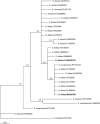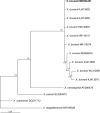Morphological, molecular and ecological characterization of a native isolate of Steinernema feltiae (Rhabditida: Steinernematidae) from southern Chile
- PMID: 33436058
- PMCID: PMC7805086
- DOI: 10.1186/s13071-020-04548-7
Morphological, molecular and ecological characterization of a native isolate of Steinernema feltiae (Rhabditida: Steinernematidae) from southern Chile
Abstract
Background: Steinernema feltiae is an entomopathogenic nematode used in biological control programs with a global distribution. Populations of this species show phenotypic plasticity derived from local adaptation and vary in different traits, such as location and host penetration. The aim of this work was to describe a Chilean isolate of this nematode species, using integrative approaches.
Methods: Nematode morphological and morphometric studies were conducted along with molecular analysis of nuclear genes. The symbiotic bacterium was also identified by sequencing the 16S rRNA gene. Some ecological characteristics were described, including the temperature requirements for the nematode life cycle and the effect of soil water content for optimal reproduction.
Results: Morphometric characterization revealed a large intra-specific variability. The isolate identity was also corroborated with the analysis of nuclear genes. Based on the 16S gene, its symbiont bacteria, Xenorhabdus bovienii, was identified. The lowest, optimal and highest temperatures found to limit the infestation and reproduction on Galleria mellonella were 10, 20 and 30 °C, respectively; the emergence from the host larvae occurred approximately 10 days after inoculation. Differences were observed in offspring, and 120 infective juveniles (IJ)/larva was the most prolific dose at 20 °C. The soil water content did not affect the number of IJ invaders, penetration efficacy and IJ emergence time or offspring per larva, but it caused a delay in achieving full mortality at the permanent wilting point with respect to saturation and field capacity.
Conclusions: For the first time, a Chilean isolate of S. feltiae is described in detail considering morphological, molecular and ecological aspects. The isolate was shown to be efficient in soil containing water, with optimal temperatures ranging from 15 to 25 °C for host infestation and production of an abundant offspring; these characteristics would allow its potential use as control agents in a wide geographical area of the country.
Keywords: Adults; Biocontrol; Juveniles; Soil water content; Symbiotic bacteria; Taxonomy; Temperature; Xenorhabdus.
Conflict of interest statement
The authors declare that they have no competing interests.
Figures






References
-
- Hunt DJ, Nguyen KB. Advances in taxonomy and phylogeny of entomopathogenic nematodes of the Steinernematidae and Heterorhabditidae. Nematology. Leiden-Boston: Brill; 2016. p. 454.
-
- Askary TH. Sociology, Organic Farming, Climate Change and Soil Science. Dordrecht: Springer; 2010. Nematodes as Biocontrol Agents; pp. 347–378.
-
- Puža V, Mráček Z, Nermut J. Novelties in pest control by entomopathogenic and Mollusc-parasitic nematodes. In: Hill H, editor. Integrated Pest Management (IPM): Environmentally Sound Pest Management. London: InTech; 2016. pp. 71–102.
-
- Hinchliffe SJ. Insecticidal toxins from the Photorhabdus and Xenorhabdus bacteria. Open Toxinol J. 2010;3:101–118. doi: 10.2174/1875414701003010101. - DOI
MeSH terms
Substances
Supplementary concepts
LinkOut - more resources
Full Text Sources
Other Literature Sources

